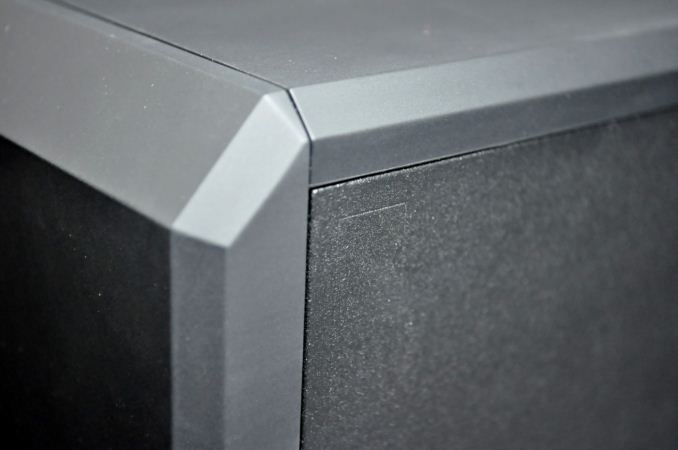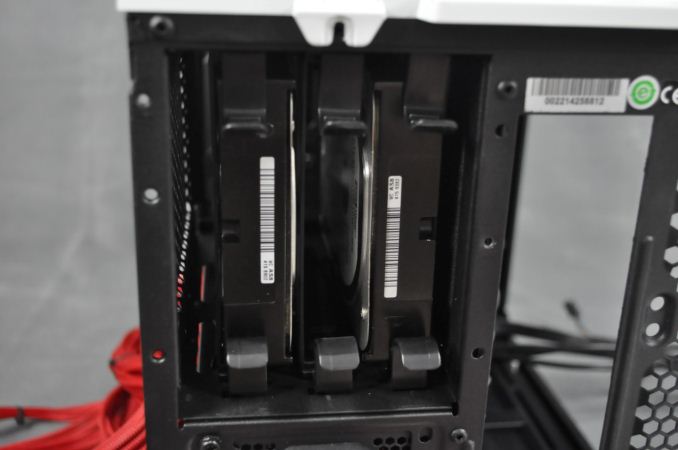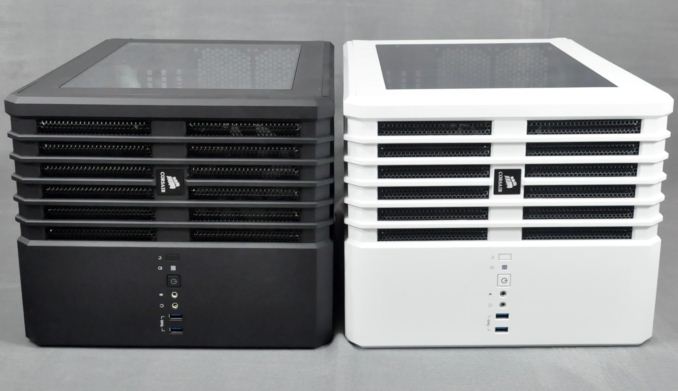Corsair Carbide Air 240 Case Review
by E. Fylladitakis on August 15, 2014 6:00 AM EST- Posted in
- Cases/Cooling/PSUs
- Corsair
- ATX
- Case
- Carbide
Corsair Carbide Air 240 Exterior
"And we shall call it…mini-540". This is what Corsair must have been thinking while designing their latest addition to the Carbide series, the Air 240. The new Micro-ATX case looks exactly like an undersized version of the Carbide Air 540 that we reviewed a little over a year ago. With a size of 315mm × 265mm × 400mm (H×W×D) and a total volume of 0.0334m3, the Carbide Air 240 is not a very compact Micro-ATX case, yet it takes less than half the volume of the Air 540 (61.55% less) and less volume than the Obsidian 350D (21.87% less). It also adds Micro-ATX compatibility over the Obsidian 250D for just 16.9% more volume.
Corsair currently offers the Carbide Air 240 in two colors, black and white, both of which are depicted in the following galleries. It is interesting to note that the metallic parts of the black version have been sprayed with a grainy, satin black paint, while a smooth matte black paint covers the plastic parts. The difference in the paint on the black isn't a major deal, but it is apparent when performing a close inspection. The white version on the other hand is immaculate, with the entire exterior having being sprayed with a satin white color.
Aesthetically, the Carbide Air 240 sports an interesting asymmetric design that hints at the internal dual-chamber configuration. The left part of the faceplate is vented, as is the left part of the top and bottom panels as well, creating exceptional cooling possibilities for the main system. We can see the I/O ports and buttons on the right middle side of the faceplate, with the company logo in alignment towards the left side of the case. The left side panel is almost entirely covered by a transparent acrylic window, revealing the entire main system to the spectator.
The top and bottom panels of the Carbide Air 240 are secured with two thumbscrews each. By removing these thumbscrews, both panels easily slide off. However, as the case actually sits on the bottom panel, it will have to be placed on its side or upside down before removing it. The removal of either panel reveals the frame for the installation of 120mm fans and/or liquid cooling radiators.
It is very interesting that Corsair went with a "rails" design, allowing the user to adjust the location of the fans/radiator by a few centimeters towards the front or the rear of the case. Each of the side panels is secured with two thumbscrews each as well, but these thumbscrews are partially threaded and do not come off the panel when removing it. The front panel can also be removed, but the user needs to first remove both side panels and undo the plastic clips that hold the front panel in place.
Even though the right side panel of the Carbide Air 240 will have to be removed before the user can wire any of the drives, both drive cages are accessible from the exterior of the case. The 2.5" drive cage is beneath the top panel, which has to be removed in order to gain access to it. The 3.5" drive cage is accessible from the rear of the case, by removing a perforated metallic cover held in place with a single thumbscrew. The plastic trays of the 3.5" cage can hold 2.5" drives as well. Strangely, even though the plastic trays have been inserted facing rightwards from the factory, they need to be installed facing leftwards in order to fit three full-size 3.5" mechanical disks.
It is also possible to use the Carbide Air 240 sideways and there are even slots on the metallic right side panel for the rubber feet that Corsair provides in the bundle. However, that will also rotate the faceplate and everything printed on it, including the I/O legend and the case badge, making the Carbide Air 240 look rather odd and off-place. The case badge is magnetic and may be rotated, but that is not true for the I/O legend and buttons.



























63 Comments
View All Comments
MichaelD - Friday, August 15, 2014 - link
I've been looking for a small-ish case to build my new gaming PC in and this was looking so promising, until I saw that it has no 5.25" bay. For a daily-use PC at least one optical drive bay is mandatory. Some of us actually still buy our games on physical DVDs and it's nice to be able to burn a DVD or CD when you need to.kmmatney - Friday, August 15, 2014 - link
Between my wife and 3 kids, and work, I have 10 computers in the house, and most of them share an external USB drive - and the need for that is rare. it would be nice if this supported a slim optical drive, though - those take little room.brbubba - Friday, August 15, 2014 - link
I thought the same thing about my Air 540 because my water reservoir takes up the two 5.25" bays, but now that my DVDRom/CDRom is gone I haven't missed it. If you are still living in the 90's and haven't made the switch to Steam then just rip ISOs of all your games.romrunning - Friday, August 15, 2014 - link
Take a look at Silverstone's SUGO series - specificially the mini-ITX SG05 model. It can take a very decently sized GPU, and you can buy the case with a 450W PSU. It has a 5.25" slot for a slimline SATA disc drive; buy the slimline SATA power adapter cable 'cause they don't include it. The Silverstone case is also significantly smaller than this case. Great gaming case for a single GPU!I bought it, and I love it. I use the disc drive for when I buy CDs on sale; it's cheaper to get whole CD of 11-14 tracks when on sale than it is to buy individual tracks as MP3 downloads. I can then rip the whole disc & add it to my music library.
Grok42 - Saturday, August 16, 2014 - link
Mandatory? I'm not sure that word means what you think it does. Do some people still buy physical media? Sure, but I can't understand why. Every game is available online and it doesn't require you juggle disks when changing games. If you don't have good Internet I could understand but then just use an external drive. Rip them as ISO files so you don't need it connected all the time. It really isn't that difficult. You can upgrade more important parts of your system with the $20 you save.hapkiman - Friday, August 15, 2014 - link
I really like my Air 540, in fact its been the best case I've ever had. This one looks like its just going to be too cramped in there for good airflow. Plus its too wide to fit under an entertainment center.I'm not sold on this one.
brbubba - Friday, August 15, 2014 - link
"We cannot really claim that it is a unique case, both because many cubic cases are available"ORLY?
SirGCal - Friday, August 15, 2014 - link
I don't understand the non-need for an optical drive. I use mine for system images, backups, etc. I constantly use it nearly every day. Not to mention just to watch a movie while I'm working... Even on my laptop, I use the optical drive with some regularity. External drives never have interested me but with a case this huge, why isn't there one slot somewhere, even on the side? I just don't get it. I also have micro-ITX builds, smaller then this, but they still have an optical drive.SirGCal - Friday, August 15, 2014 - link
err Micro-ATX and Mini-ITX. I actually have both right now. Not a fan of the ITX honestly. One PCIe seems to be a problem when I want to use a PCIe SSD setup along with a deticated GPU. But that's another topic. Still, micro builds, for many of us, still need optical drives just for daily usage.ZeDestructor - Saturday, August 16, 2014 - link
For most people, backups, system images and all manner of not commonly accessed data (like movies, game installer and the like) goes on external drives or NAS boxes, if only for the convenience.Meanwhile, a 100pc DVD-R spindle costs $23.68, which works out to $94.72 for ~2TB. A single 2TB 7200rpm HDD costs $93. In addition, the HDD is faster, rewritable and takes significantly less space, and much more convenient since you don't have to swap disks as often.
Just yesterday I was helping a friend wrap up his NAS4Free install with ZFS (inside ESXi, fuck you VMware for removing RDMs from the vclient ui!), something he's doing to get a nice, always on, accessible anywhere library of media, mostly so that he can brick his PC(s) while watching movies on his projector.